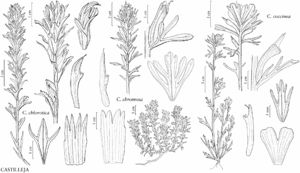Castilleja chlorotica
Proc. Biol. Soc. Wash. 33: 104. 1920.
Herbs, perennial, 0.8–3.1 dm; from a woody caudex; with a taproot. Stems several to many, erect to ascending, unbranched, sometimes branched near base, hairs spreading, long, soft, eglandular, mixed with dense, short-stipitate-glandular ones. Leaves green, narrowly to broadly lanceolate or oblong-lanceolate, 9–35 cm, not fleshy, margins wavy, involute, 0 (–3) -lobed, distal sometimes 3-lobed, apex narrowly acuminate; lobes ascending or spreading, linear to lanceolate, apex acute to obtuse. Inflorescences 3–9 (–18) × 2–3 cm; bracts green to pale green to rarely dull purplish brown throughout, distally rarely with pale-yellow apices, narrowly lanceolate to narrowly elliptic to sometimes broadly lanceolate, 3-lobed, wavy-margined; lobes spreading or ascending, narrowly lanceolate, medium length, arising at or above mid length, sometimes wavy-margined, apex obtuse to acute. Calyces green or yellowish green, 15–19 mm; abaxial and adaxial clefts 9–11 mm, 60% of calyx length, deeper than laterals, lateral 3.5–7 mm, 15–25% of calyx length; lobes broadly or narrowly triangular, taller than wide, apex acute to obtuse. Corollas conspicuously decurved distally, 18–22 mm; tube 11–14 mm; beak exserted, adaxially green to yellow-green or yellow, 6–8 mm; abaxial lip green, reduced, fleshy, included, 1.5–2 mm, 25% as long as beak, sparsely hairy, hairs spreading; teeth ascending, green, 0.5–1 mm.
Phenology: Flowering Jun–Aug.
Habitat: Dry open pine forests, often with sagebrush understory, rocky ridges and summits, montane to subalpine.
Elevation: 2000–2500 m.
Discussion
Castilleja chlorotica is an uncommon to rare endemic on dry slopes in Deschutes, Klamath, Lake, and possibly Crook counties in central Oregon. The hooked corolla beak and greenish bracts, often aging purplish distally, help distinguish it from similar species such as C. glandulifera and yellow forms of C. applegatei var. pinetorum.
Selected References
None.
Lower Taxa
"taller than wide" is not a number.
